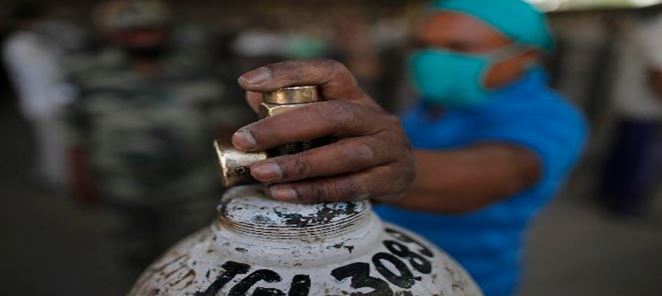
A man waits to refill a medical oxygen cylinder at a charging station on the outskirts of Prayagraj, India, on April 23. (Rajesh Kumar Singh/AP)
Opinion by Francesca Recchia and Suchitra Vijayan
Francesca Recchia, a researcher, writer and former director of the Institute of Afghan Arts and Architecture at Turquoise Mountain, is the editor and creative director of the Polis Project. Suchitra Vijayan is a barrister, researcher and the author of “Midnight’s Borders: A People’s History of Modern India.” She is the executive director of the Polis Project.
As India reeled from the devastating and catastrophically mismanaged second wave of the covid-19 pandemic and its government ordered social media platforms to censor critical content, our Twitter account, “Watch the State,” was temporarily restricted twice in one week — the first time globally, the second time only in India — after sharing news articles related to the unfolding crisis.
In December 2019, when protests against the Citizenship Amendment Act broke out in India, student protesters approached our organization asking for support in tracking the growing police violence against citizens. We set up a system to document instances of state violence against protesters, which included illegal detention and custodial torture, the use of tear gas, surveillance, police brutality and hate speech. Over time, the “Watch the State” account maintained a database of political prisoners in India and worked to gather evidence of excessive use of force during the pogroms in Delhi in February 2020. We later started documenting the deadly combination of state violence, inaction and negligence that characterized the Indian government’s management of both the first and second wave of the pandemic.
Since March, as the Indian health infrastructure completely crumbled, social media platforms have become the de facto helplines where helpless citizens ask for help and offer mutual support. To maintain a lived memory of the present and gather evidence to hold the state accountable, our account has been collecting and sharing instances of state violence from reliable news sources. The Twitter restrictions, for a few hours each on April 22 and April 29, happened soon after we started curating regular threads with reports published by national and international news outlets.
Twitter’s moderation policies around these kinds of restrictions are opaque. According to its policy, Twitter places “temporary limitations on certain account features” if an account “appears to be compromised or in violation of the Twitter Rules or Terms of Service.” It is unclear how our posts could have done so or how many others might have been affected.
We have no evidence as to who or what spurred the restrictions, and Twitter has not provided an explanation, nor did it notify us.
But there have been many media reports on how the Bharatiya Janata Party-led Indian government ordered Facebook, Instagram and Twitter to censor dozens of posts criticizing the administration’s response to the pandemic. Twitter complied with the Indian government’s request and took down 52 tweets by elected officials, journalists and editors that criticized the government’s response to the pandemic. Twitter also suspended Hindutva Watch, an account that shared news reports published by mainstream Indian outlets.
Facebook, meanwhile, temporarily blocked posts with the hashtag #ResignModi. More than 12,000 posts calling for the resignation of Indian Prime Minister Narendra Modi were briefly hidden on April 28; a Facebook spokesperson later said that it was a “mistake” and not at the request of the government, but the damage was done.
The silencing of critical voices is not new. The Indian government has consistently restricted and censored physical and online spaces by abusing local laws and imposing a series of regulations aimed at tech giants. These include getting social media and tech companies such as Facebook, Instagram and Twitter to censor content and issuing orders that restrict free speech. These arbitrary restrictions have been put in place without transparency, accountability or respect for due process.
Much of what India is experiencing today has been fully tested over decades in Kashmir and other so-called “disturbed” states, where military and political impunity, accompanied by the erasure or incarceration of antagonistic voices, have long been the norm. A 2019 report by Committee to Protect Journalists found that nearly 1 million tweets have been removed since 2017.
Since 2014, the Indian government has built an incredibly efficient communication machine that aims to criminalize dissent, spread fake news through its IT cells, and censor or distort information related to protests and democratic opposition. The government also shut down the Internet at protest sites, arrested journalists for tweeting, filed baseless or manufactured criminal charges against journalists, and used draconian sedition laws against academics and activists.
As the BJP government employs similar strategies to censor and intimidate voices critical of its mishandling of the covid-19 crisis on social media, India is seeing an unprecedented surge in covid-19 cases and deaths. At the same time, the state of Uttar Pradesh threatened action against hospitals and individuals that put up notices about the lack of oxygen, hospital beds and essential medicines, and filed criminal cases against people asking for medical help, even as the central government declined help from the United Nations.
The Modi government has been accused of manipulating and misrepresenting gross domestic product numbers and hate-crime data and, most recently, grossly underreporting covid-19 deaths. In the absence of credible information, many organizations use social media to provide information to the public and demand transparency and accountability from authorities. These restrictions shed light on how digital authoritarianism works to surveil, repress and intimidate many of us working on documenting negligence and institutionalized human rights violations.
Post Disclaimer
Disclaimer: Opinion: In India, social media is a lifeline. It’s being silenced - Views expressed by writers in this section are their own and do not necessarily reflect Latheefarook.com point-of-view